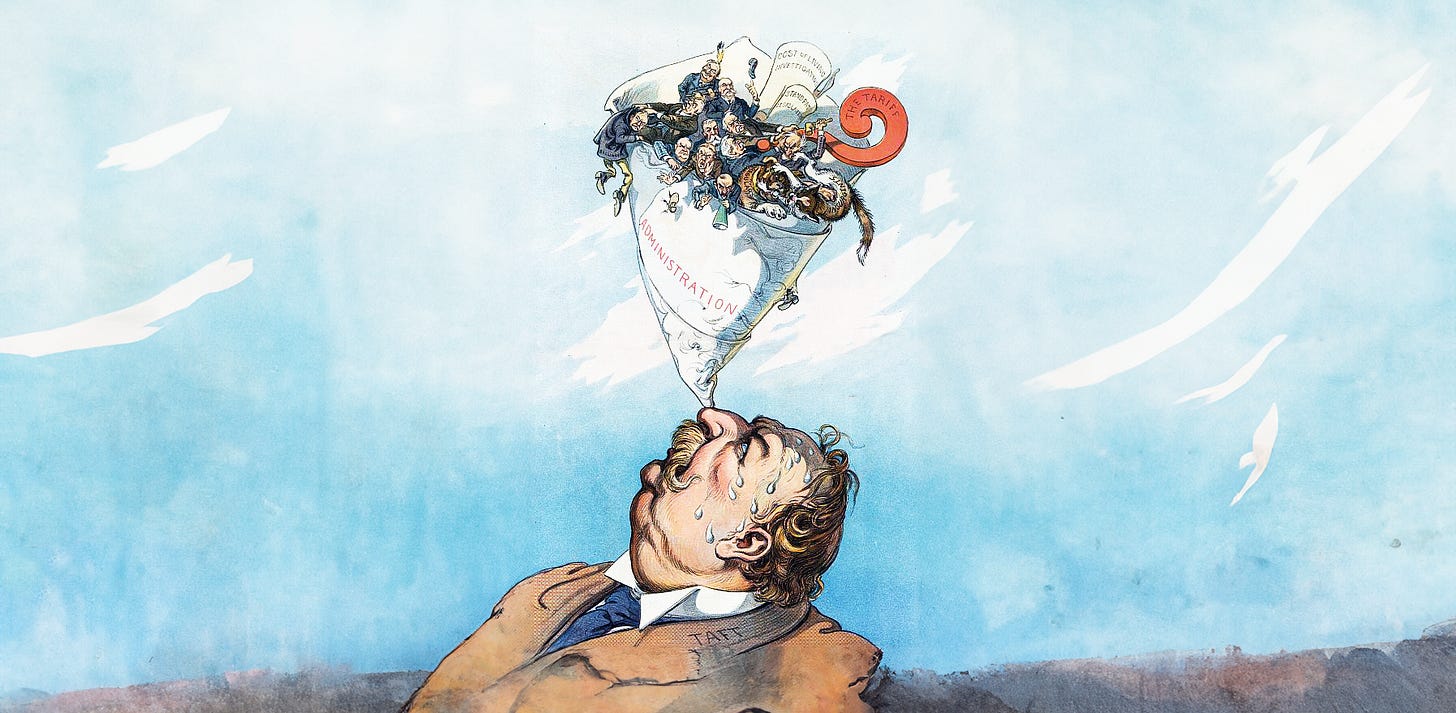
In the annals of American leadership, few figures cut so poignant a contrast as William Howard Taft—a man whose heart yearned for the quiet dignity of the Supreme Court yet found himself thrust into the turbulent arena of the presidency. Born in 1857 to a Cincinnati family steeped in political prominence, Taft was no stranger to power’s trappings, yet he lacked the raw instinct for its game.
A lawyer by trade, he had honed his skills as governor of the Philippines and Theodore Roosevelt’s Secretary of War. These roles burnished his credentials without ever igniting a passion for elected office. When Roosevelt, that dynamo of American vigor, anointed him as successor in 1908, Taft rode the wave of that endorsement to a landslide victory over William Jennings Bryan, capturing the White House with a smile as broad as his considerable frame. But beneath the triumph lay a truth: Taft had no feel for politics, no nerve for its controversies—a gentle giant ill-suited to the storm ahead.
Taft’s single term, from 1909 to 1913, unfolded like a ledger of gains and losses, successes penned in bold ink beside failures etched in shadow. A man of law above all, he sought fairness with a judge’s precision. Yet, in the hands of conservative Republicans longing for a quieter executive, he became a pliable tool, a stark departure from Roosevelt’s roaring tenure. His four years in office would prove a mere prelude to the greater mark he left later as Chief Justice of the Supreme Court from 1921 to 1930—a role history deems far more significant than his time at the nation’s helm.

In matters of justice, Taft showed a steady hand. He lent his support to Booker T. Washington’s noble crusade to “uplift” African-American citizens. He stood firm for free immigration, vetoing a congressional measure that would have shackled unskilled laborers with a literacy test. He imposed a corporate income tax on the fiscal front, coaxing over $13 million into the national coffers—a modest but meaningful stride toward equity.
His wife, Nellie, brought grace to the administration. With a diplomat’s touch, she welcomed Japan’s gift of thousands of cherry trees, planting them along the Tidal Basin in Washington, D.C. Each spring, their blossoms transformed the capital into a fleeting Eden, a legacy of beauty that endures.
Taft found allies among progressive Republicans in the Senate, forging reforms that bore the stamp of progress: laws to safeguard miners and railroad workers, the creation of a Children’s Bureau within the Department of Labor, and an eight-hour workday for federal employees. His trust-busting zeal outpaced even Roosevelt’s, with 90 antitrust suits in four years, including a bruising case against U.S. Steel that stung his predecessor by implicating Roosevelt’s own decisions.
And then there were the constitutional milestones—two amendments sent to the states under his watch: the Sixteenth, birthing a graduated income tax, and the Seventeenth, mandating the direct election of senators. Yet, these were less triumphs of Taft’s will than harbingers of his unraveling.
Taft’s presidency faltered where his instincts clashed with the currents of his time. He had campaigned on lowering tariffs to ease the burden on ordinary folk, but his murky stance and reluctance to wield the veto birthed the Payne-Aldrich Act of 1909. This measure raised tariffs, shielding big business at consumers’ expense. Progressives cried betrayal, and the rift within his party widened, a wound that bled into the 1910 midterms, where Republicans lost the House and saw their Senate grip weaken.
His devotion to the law, admirable in a courtroom, proved a liability in the wilds of politics. When he discovered Roosevelt’s hydroelectric power sites had been misdesignated as ranger stations, Taft undid them with a jurist’s rigor, firing Gifford Pinchot, Roosevelt’s trusted forester. The move enraged his mentor, who later branded him a “puzzlewit” and “fathead,” words that cut deeper than policy disputes.
In foreign affairs, Taft championed “dollar diplomacy,” a vision crafted with Secretary of State Philander C. Knox to extend American influence through economic might rather than bullets. It was a grand notion—to refinance Haiti’s debt, fund its railroads, press treaties on Nicaragua and Honduras, even join a consortium to build railroads in China, where Taft himself lobbied the prince regent in 1909.
Yet, his naiveté shone through—dollars alone could not quell unrest. When he sent Marines to Nicaragua and the Dominican Republic in 1912 under the Roosevelt Corollary, anti-American fires flared. The policy faltered, unable to stem revolutions or secure stability, a dream undone by its limits. His quest for world peace through a global court and arbitration treaties foundered, too. A “policy of harmony” with Congress smoothed domestic wins but failed to rally support for these ideals, drawing Roosevelt’s scorn by 1910.
The Sixteenth and Seventeenth Amendments stand as towering markers of Taft’s era, yet their story is one of fracture, not mastery. The income tax began as a sop to progressives during the tariff wars of 1909, with Taft signing a 1% corporate levy. However, conservatives like Senator Nelson Aldrich misjudged the tide when they proposed the Sixteenth Amendment to forestall broader taxation. The Republican Party, split between progressives hungry for reform and conservatives clinging to tradition, lost its moorings after the 1910 elections. Democrats, newly ascendant in the House, joined progressive Republicans to propel the amendment through Congress by July 1909. It was ratified in 1913, after Taft’s departure—a victory not of his making but of his party’s disarray.

The Seventeenth Amendment followed a similar path. Progressives like Robert La Follette decried the corrupt “Millionaires’ Club” of the Senate, chosen by state legislatures beholden to bosses and trusts. Taft, ever the conservative at heart, resisted this populist surge. Still, by 1911, with Democrats commanding the House and progressive senators defecting, the measure passed Congress in May 1912 and was ratified in 1913. Democrats drove their success, seizing on Republican chaos, while Taft stood sidelined, a witness to reforms he neither birthed nor embraced.
The Seventeenth Amendment, ratified on April 8, 1913, marked a seismic shift in American governance by stripping state legislatures of their power to elect U.S. Senators and placing that authority directly in the hands of the people. This change, enacted during the waning months of Taft’s presidency, was less a sudden innovation than the culmination of decades of discontent, rooted in the original design of the Constitution and the Progressive Era’s clamor for reform.
Before the Seventeenth Amendment (1789–1913), the election of U.S. Senators was under Article I, Section 3 of the Constitution, and state legislatures chose senators, a mechanism crafted by the framers to balance federal power and ensure states had a direct voice in Congress. This reflected a distrust of unchecked democracy, favoring elite deliberation over popular will.
In practice, it made senators beholden to state political machines—often coalitions of party bosses, industrialists, and local magnates—rather than the broader electorate. By the late 19th century, this system had devolved into a cesspool of corruption: bribery scandals, deadlocked legislatures, and vacant Senate seats became commonplace as factions vied for control. Between 1891 and 1905, for instance, nine bribery cases rocked state elections, while deadlocks in states like Delaware left seats empty for years.
The Progressive Era, spanning the 1890s to the 1920s, brought this dysfunction into sharp relief. Reformers—journalists, populists, and lawmakers like Wisconsin’s Robert La Follette—decried the Senate as a “Millionaires’ Club,” a bastion of wealth and privilege insulated from public accountability.
Muckraking exposés, such as David Graham Phillips’s 1906 series The Treason of the Senate, spotlighted senators like Nelson Aldrich of Rhode Island, whose ties to corporate trusts epitomized the era’s cronyism. Public outrage swelled, and by 1900, grassroots movements—bolstered by the Populist Party and later the Progressive movement—demanded direct elections to break the stranglehold of machine politics. States began experimenting—Oregon’s 1901 “Oregon System” used advisory primaries to pressure legislatures, a model that spread to over half the states by 1912.
The push gained traction in Congress after the 1910 midterms, when Democrats seized the House and progressive Republicans, alienated by Taft’s conservatism, joined forces. By 1911, over two-thirds of state legislatures had petitioned Congress for a constitutional convention—a threat that spurred action. The House, now Democratic, passed direct-election bills repeatedly, only to see them die in the Senate, where entrenched conservatives resisted.
Taft, a traditionalist who prized the framers’ design, offered no support, but the tide turned in 1911–1912. Progressive senators, elected by reform-minded legislatures after 1910, tipped the balance. On May 13, 1912, the amendment cleared Congress—House vote 238–39, Senate 54–33—driven by a coalition of Democrats and defecting Republicans, not Taft’s leadership.
Sent to the states, the amendment raced to ratification in less than a year, reflecting widespread public demand. It transformed the Senate from a creature of state elites into a body answerable to voters, aligning it with the democratic ethos of the House. Critics, including Taft’s conservative allies, mourned the loss of state sovereignty, fearing a Senate swayed by fleeting popular passions rather than deliberative restraint.
In practice, for all its noble intent, the Seventeenth Amendment merely traded one form of corruption for another. Where once state legislatures, steeped in their venal intrigues, held sway over the Senate’s composition, now the corruption has slipped into the hands of lobbyist cabals—those deft architects of influence who pour their largesse into campaigns and personal coffers. The senators, once tethered to the machinations of local bosses, now dance to the tune of distant paymasters, leaving the nation, in a rueful twist of fate, mired once more in the very mire of self-interest the amendment sought to escape.
To call these successes or failures is to miss the mark. They were not Taft’s to claim—instead, they were the fruit of his inability to bind his party or steer its course. The long-term toll was steep: the income tax swelled federal power, a specter conservatives dreaded, fueling expansions that Taft’s allies would lament. Direct elections stripped state legislatures of their Senate voice, tilting the balance toward populism and eroding the party machines Republicans once wielded. These shifts deepened the GOP’s fracture, setting the stage for its 1912 collapse and a Democratic resurgence that outlasted Taft’s time.
The breach with Roosevelt was Taft’s undoing. His legalism, trust-busting clash over U.S. Steel, and ousting of Pinchot all fueled a rift that burst into the open in 1912. Roosevelt challenged him for the Republican nomination, winning 278 delegates to Taft’s 48. Still, loyal to Taft, party bosses locked out Roosevelt’s men at the Chicago convention, securing Taft’s nod on the first ballot.
Undeterred, Roosevelt forged the Progressive Party—the Bull Moose—its platform a clarion call for women's suffrage, conservation, a minimum wage, and an end to child labor. Taft clung to the Republican banner, but the split was fatal.
Four men vied for the presidency that year, each cloaked in progressive garb: Taft, Roosevelt, Woodrow Wilson of the Democrats, and Eugene V. Debs, the Socialist who claimed 6% of the vote—over 900,000 souls. The Republican ballot shattered, Taft garnered eight electoral votes, Roosevelt trailed Wilson, and the Democrats swept to victory. Taft’s presidency ended on March 4, 1913, a quiet exit for a man outmatched by his age.
In 1921, fate granted Taft his true calling. Appointed Chief Justice by Warren G. Harding, he took his seat on the Supreme Court, the only president to do so. There, until 1930, he found his element, shaping the law with a steady hand—a legacy that outshone the turbulent years in the White House, where he had been, in the end, a lawyer adrift in a sea of politics.
BIBLIOGRAPHY
"U.S. History." OpenStax, 2016.
The American Yawp. Stanford University Press, 2022.
Schweikart, Larry, and Michael Allen. A Patriot's History of the United States: From Columbus's Great Discovery to the War on Terror. New York: Sentinel, 2004.
Zinn, Howard. A People's History of the United States. New York: Harper & Row, 1980.



